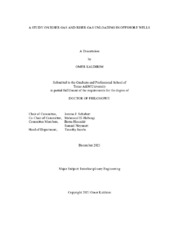| dc.description.abstract | The primary purpose of this study was to investigate riser gas behavior, unloading, and the possibility of using back pressure to control and prevent riser gas unloading. Gas entering a well may be challenging to detect in deep-water wells with the large column of mud located in the riser and the lengthy annulus extending beneath the seabed. If undetected and left alone, the gas kick can migrate into the riser and lead to loss of well control, riser unloading, and blowout. This dissertation investigates gas migration, expansion, riser gas unloading, and how to safely circulate gas influxes in deep-water conditions through experimentation and simulation.
Conventional well control operations include shutting in the well, applying well control methods, and circulating the gas out of the well using the subsea choke and kill lines. However, in some cases where the gas kick goes undetected, shutting in the well using the subsea Blowout Preventers (BOP) may be too late as the gas influx may have entered the riser. Conventional offshore drilling utilizes an open-top riser with a flow line returning the mud from the top of the riser. Gas entering the riser in water-base muds expand and travel up the riser. The primary driver of the gas movement in non-circulating situations is initially be migration dominated then expansion dominated. In oil-base muds, gas remains in solution until the bubble point is reached and then begins bubbling out of the solution. Then, the gas bubble that is liberated from the mud begin expanding. In both cases, if left uncontrolled, the rapid gas expansion can discharge fluid from the top of the riser onto the rig floor at very high rates leading to a blowout, injuries, fatalities, and loss of well and rig.
The first step of this study is to review the expansion rate of a gas kick using flow loops in the Dual Gradient Drilling (DGD) and Tower Labs located at Texas A&M University and run CFD simulations to verify and scale up the results. The second step is to use the CFD simulations to observe the effects of applying surface back pressure on the impact of gas expansion and riser unloading to study Dynamic Influx Management methods produced through Managed Pressure Drilling (MPD) systems.
The results of this study provide information on the physics behind the sudden gas expansion and unloading of risers during offshore operations and opportunities created with MPD systems to manage riser gas, reduce NPT and improve operational safety and reliability. | |


